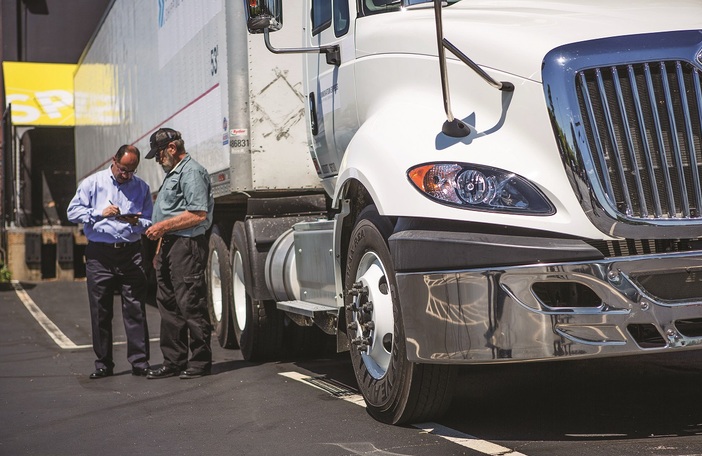Twisting and turning into a loading dock a few dozen times a day eats on-highway tires, but regional tires are built to take that sort of punishment. Photos: Jim Park
Many regional fleets are splitting more of their time these days between traditional highway driving and urban driving. A truck might start the day in suburban Cleveland, drive to Columbus with a few inner-city deliveries in the morning, then head up to Toledo for some afternoon drop-offs before shooting home at the end of the day. A fleet running that kind of route on a daily basis will want a high-fuel-efficiency tire, but also a tough, durable tire that can withstand the rigors of city driving. Long miles to removal would be as important an attribute as resistance to scrubbing and curb impacts.
Regional tires suffer all sorts of abuse that a typical highway tire hardly sees, such as tread scrubbing from tight turns. This can be particularly hard on steer tires, but drives and trailer tires get beat up as well while backing into docks and maneuvering in tight spots. Then you have the rough and uneven surfaces – often strewn with gravel – that also make unfavorable impressions on tire tread.
Frequent starts and stops are also hard on tires. There’s higher potential for tread wear, of course, especially with aggressive drivers. On top of that, the torque applied to the sidewalls during acceleration and braking is higher and more frequent than most on-highway tires are exposed to.
Tire makers combat these challenges with several design strategies, such as rubber compounding, as well as careful design of sidewalls, casings, tread and shoulders. Casing life can be extended with curb guards to protect the sidewalls from impacts and abrasions, while groove-bottom protectors guard against stone-drilling that can damage the casing, Michelin says.
“We offer a variety of both new tire and retread products that fall into this area,” says Paul Tatarchuk, B2B special services coordinator, Michelin North America. “When selecting a tire for regional applications, make sure that the tire is indeed designated for such use.” Michelin denotes the name for regional applications as “X Multi” and “X InCity” for urban applications. Its data books show the “winding road” graphic designation for tires with characteristics engineered for strenuous regional environments.
Curbs are the arch-enemies of trailer tires in city pickup-and-delivery work. Life expectancy for tires on the right side of the trailer is significantly lower than other tires because of curb strikes and sidewall damage. All trailer-tire sidewalls are at some risk, so investing in a tougher and more resilient sidewall is usually worth the money. Repositioned on-highway steer and drive tires won’t withstand such attacks as well as purpose-built regional tires will. The associated downtime from a curb strike is one thing, but the loss of a valuable casing is a double slap in the face.

Curb strikes are inevitable in the close confines of a city. Guard against excessive damage with treads and sidewalls designed for the application.
“Regional trailer tires should be engineered to withstand high scrub conditions and be resistant to chips and cuts, so they can handle the rigors associated with spread-axle and drop-deck trailer applications,” notes Gary Schroeder, global director of Cooper Tire’s truck and bus tire business. “Regional tires can be retreaded, and the casing of all Cooper Pro and Work Series tires is designed and warrantied for multiple retreads.”
At the extreme end of the regional spectrum are the roll-off and waste haulers. These trucks get into some ugly areas and need all the help they can get from their tires. Such tires need to be tough and versatile, with the ability to withstand high-scrub conditions, Schroeder says. “They must manage severe turning and impact, so they need robust construction capable of carrying a heavy load and corresponding inflation pressure, plus deep, wide treads designed to deliver tread wear life.”
So how do you know which tire is right for you? Just like highway tires, different brands and different models can perform differently because of tread and casing design as well as the rubber compounding used in the tire.
“When selecting new tires, we strongly encourage regional fleets to consult with an experienced commercial tire dealer, who can assess the fleet’s tire needs and make appropriate recommendations,” says Mahesh Kavaturu, Goodyear marketing manager. “Dealers also can help develop a tire maintenance plan, including inflation management, that will help fleets drive down their operating costs.”
Maintaining proper inflation pressure levels, for example, is critical, and under-inflation, in particular, should be avoided. Under-inflation can lead to irregular wear and force truck engines to work harder, which leads to increased fuel consumption – just like with on-highway tires. In this way, regional tires are no different; they still need proper care and feeding.
“Fleets should check their tire inflation levels at least once a week, using a calibrated tire gauge, and more often, if possible,” Kavaturu says. “We cannot overstate the importance of tire inflation maintenance. This applies to truck tires for all vocations — not just regional.”
If your fleet is seeing an increase in regional work, you should consider looking at the appropriate tires for the job. The tires on your repurposed highway trucks may work, but they likely won’t last as long as you might expect. A few weeks in the inner city is like a few months out on the big road.
by Jim Park
Source: https://www.truckinginfo.com
CUT COTS OF THE FLEET WITH OUR AUDIT PROGRAM
The audit is a key tool to know the overall status and provide the analysis, the assessment, the advice, the suggestions and the actions to take in order to cut costs and increase the efficiency and efficacy of the fleet. We propose the following fleet management audit.




